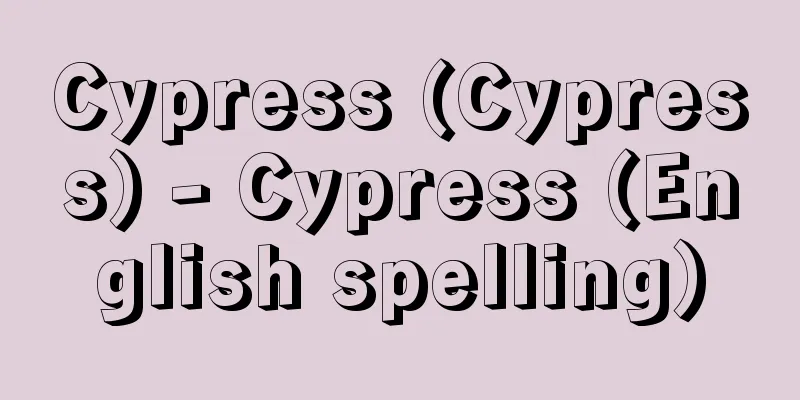Fishery Finance

|
A general term for the lending and borrowing of funds and the giving and receiving of credit to the fishing industry (including aquaculture). Unlike agriculture, which is a single-structured industry, the Japanese fishing industry was originally a complex structure made up of small producer fishermen, small and medium-sized fishing capital, and large capital, but as the 200-mile system became established, large capital based on deep-sea fishing withdrew from fishing production, with the exception of a few industries, from the second half of the 1980s onwards. System financial institutions such as the Shinkin Federation of Fisheries Cooperative Associations (Shingyoren), the Norinchukin Bank (Norinchukin), and fishing cooperatives (Gyokyo) play an important role in providing funds to fishing households and small and medium-sized fishing capital. [Seiichiro Ono] FundingThe majority of loans to the fishing industry, both for capital equipment and working capital, are provided by system financial institutions, primarily the Japan Fisheries Federation, followed by general financial institutions, primarily regional banks and credit unions, which lend primarily for working capital. The overall share of government financial institutions, which lend almost 100% for capital equipment, is less than 10%. Looking at trends in the 21st century, the latter two have declined, and the weight of system financial institutions has been increasing. As of 2008, system financial institutions accounted for just under 70% of the total loan amount, with Shingyoren accounting for 50%, and the former for 80% of capital equipment loans and the latter for over 60%. System financial institutions are a three-tiered system consisting of Fisheries Cooperatives, Shingyoren and Norinchukin Bank, but due to the accelerated merger of Fisheries Cooperatives, at the end of February 2008, 34 prefectures had established a one prefecture, one credit business responsibility system (a system in which the credit business of fisheries cooperatives is integrated at the prefectural level). There are three types of this: (1) one fisheries cooperative per prefecture (implemented in nine prefectures as of the end of February 2008), (2) an integrated Shingyoren in which the fisheries cooperative transfers its credit business to Shingyoren, and (3) a system in which Shingyoren and multiple independent fisheries cooperatives operate in an integrated manner. In Hokkaido, Nagasaki, Ehime, Miyagi and Miyazaki, which use type (3), a re-deposit and on-lending system (in which fisheries cooperatives deposit money in the prefectural Fisheries Cooperatives and use the money borrowed from the prefectural Fisheries Cooperatives to cover loans) is being promoted. Fisheries finance is characterized by a hierarchy in which fishermen are the providers of funds and business owners, including those in the aquaculture industry, are the demanders of funds. The ratio of loan balances to the value of fisheries production was nearly 20% in 2000, but fell to just under 90% in 2007. Overall, loan amounts have fallen by 40-50% since 2000, with the balance shifting to system financial institutions. [Seiichiro Ono] Global standardizationAfter the Second World War, Japan tried to maintain the stability of the financial system through various regulations, resulting in an overprotective "convoy system" that adjusted standards to the weakest financial institutions. The global standardization that began with financial liberalization in the late 1980s was strengthened in the process of overcoming the "Heisei recession," and discretionary regulations based on this convoy system were forcibly modified. As a result, fishing finance, which is at the end of the convoy, is more governed by the characteristics of natural industries than agriculture, both in the fishing industry, which is a harvesting production industry with fishing boats as the main means of production, and in aquaculture, which is the livestock industry of agriculture, and is difficult to adapt to market principles, and the total loan balance in 2008 was 54.1% of that in 2000. Profitability fluctuates due to the instability of catches and is worsening, and replacement ship construction cannot be started despite the aging of fishing boats (aging of fishing boats), so there are high expectations for the fishing boat leasing system. Furthermore, for long-term inventory financing (the supply of working capital for farmed fish, which take two to three years to grow), it will be necessary to design a system for "liquid asset-backed loans" that use farmed fish as collateral. [Seiichiro Ono] Institutional FinanceSince the period of high economic growth, through the contraction and reorganization under the 200-mile system, institutional finance that receives financial assistance has been centered on (1) funds from the Japan Finance Corporation (formerly the Agriculture, Forestry and Fisheries Finance Corporation), which are funded by fiscal funds, (2) fisheries modernization funds funded by system financial institutions' funds, and various management stabilization funds issued from emergency loan funds in 1976, with the Small and Medium Fisheries Loan Guarantee Insurance System fulfilling the function of credit supplementation. However, institutional finance that has become integrated with the growth of the fishing industry has led to the accumulation of bad debts through stopgap investments during periods of contraction, leading to the collapse of fishing management and fishing cooperatives, and has instead become a burden on the reorganization of the fishing industry. Financial support measures for individual management have been promoted by inducing and mobilizing funds through interest subsidies, i.e., "financialization of finances." However, despite policy approval from administrative agencies, guarantee agencies do not provide guarantees considering the risks, and financial institutions generally do not lend without credit guarantees. In accordance with the Fisheries Basic Act (Act No. 89 of 2001), the financial system has been revised and a wide variety of policy support has been prepared, but the system has become dysfunctional due to a gap between the development and expansion of the system and the actual financial situation. The uniqueness of fishery finance has been lost, and there is a strong tendency to purify and dissolve it into financial policy in general. [Seiichiro Ono] The Role of "JF Marine Bank"JF Marine Bank, which operates the fisheries cooperative credit business, is a collective name for a group consisting of fisheries cooperatives, fishery processing cooperatives, Shingyoren, Norinchukin Bank, and the National Federation of Fisheries Cooperative Associations, with Norinchukin Bank playing a leading role. Based on the Law Concerning the Reorganization and Strengthening of Credit Business by the Norinchukin Bank and Specified Agricultural and Fishery Cooperatives, etc. (abbreviated as the Reorganization and Strengthening Law) enacted in 2003, JF Marine Bank expanded and strengthened its safety net (mutual assistance system) in preparation for the full lifting of the payoff (payment of deposit insurance benefits) ban (partial lifting in April 2002). It also set up a "Safety System" (a system responsible for the stable operation of credit business), and as its first basic task, it has been working since fiscal 2007 to reduce and eliminate the fixed debt (non-performing loans) of fisheries cooperatives. Fisheries cooperatives, which are the core of fisheries financing in both deposits and loans and the hands and feet of the system financial institutions, have been left unattended for many years with a carryover deficit of about 45 billion yen. The restructuring of the credit guarantee insurance system will be carried out in conjunction with the scheme (plan) for eliminating the deficit of over 40% of the outstanding loan balance of fishery cooperatives. In the current situation where the very survival of the fishing industry as an industry is in question, how to restructure the fishing industry financing system is a difficult problem. [Seiichiro Ono] "Masaharu Demura, 'The Current State and Issues of Fisheries Finance'" (Fisheries Promotion, No. 451, 2005, Tokyo Fisheries Promotion Association)" ▽ "Seichiro Ono, 'Fisheries Economics - A Policy Approach', pp. 183-184, 199-204 (2007, Seizando Shoten)" ▽ "Takehiro Osugi, 'New Fisheries Cooperative Measures'" (Monthly Fisheries and Fisheries Cooperatives, March 2008, Fisheries Cooperative Management Center Publishing Division)" ▽ "Fisheries Agency, 'Outline of Fisheries System Finance' (2009)" [Reference items] | | | | |Source: Shogakukan Encyclopedia Nipponica About Encyclopedia Nipponica Information | Legend |
|
漁業(養殖業を含む)に対する資金の貸借、信用の授受の総称。日本の漁業はもともと、単一的構成の農業とは違って、小生産者的漁家、中小漁業資本、大手資本からなる複合的構成をもっていたが、200海里体制が定着するにつれて、遠洋漁業を基盤とする大手資本は、1980年代後半以降、ごく一部の業種を除き漁業生産から撤退した。漁家ならびに中小漁業資本の資金は、信用漁業協同組合連合会(信漁連)、農林中央金庫(農林中金)、漁業協同組合(漁協)などの系統金融機関が重要な役割を担っている。 [小野征一郎] 資金供給漁業に対する融資残高は、設備資金・運転資金ともに信漁連を中心とする系統金融機関が主部を占め、運転資金を主体に貸し付けている地方銀行・信用金庫を主とする一般金融機関がそれに続く。ほぼ100%を設備資金に貸し付けている政府金融機関の全体のシェアは1割未満である。21世紀の動向をみると、後二者が後退し、系統金融機関の比重がますます高まっている。 2008年(平成20)時点では、融資総額は系統金融機関が合計の7割弱、うち信漁連が5割を占め、設備資金は前者が8割、後者が6割を超える。系統金融機関は、漁協―信漁連―農林中金の三段階制であるが、漁協合併の加速により、2008年2月末、34都道府県で1県1信用事業責任体制(漁協の信用事業を県段階で統合する体制)が築かれた。それには、(1)1県1漁協(2008年2月末時点では9県で実施)、(2)漁協から信漁連へ信用事業を譲渡する統合信漁連、(3)信漁連と複数自立漁協による一体的運営、の3形態がある。(3)の形態をとる北海道・長崎・愛媛・宮城・宮崎では、再預け転貸方式(漁協は県漁連に預金し、県漁連からの借入金を貸付金に充当する)が推進されている。漁家が資金供給者、養殖業を含む企業経営者が資金需要者という階層性が漁業金融の特徴である。漁業生産金額に対する融資残高の比率が、2000年には2割近く上回っていたが、2007年には9割弱に低下した。全般に融資額は2000年対比で4~5割減少し、そのなかで系統金融機関に傾斜している。 [小野征一郎] グローバルスタンダード化第二次世界大戦後、日本では各種規制によって金融システムの安定性を維持しようとし、結果として最弱の金融機関に基準をあわせるという、過保護体制の「護送船団方式」がとられていた。1980年代後半の金融自由化から始まるグローバルスタンダード化が、「平成不況」の脱却過程において強められ、この護送船団方式による裁量的規制が強行的に改変された。その結果、船団の最後尾に位置する漁業金融は、漁船を生産手段の基軸とする採取生産の漁業、農業の畜産業にあたる養殖業のいずれもが、農業以上に自然産業としての特性に支配され市場原理になじみがたく、2008年の全融資残高は2000年比54.1%に減少している。漁獲の不安定性から収益性が変動するうえにそれが悪化し、高船齢化(漁船の老朽化)が進んでいるにもかかわらず代船建造に着手できないため、漁船リース制度に対する期待が大きい。また在庫金融(成長に2~3年を要する養殖魚に対する運転資金の供給)が長期にわたる養殖金融には、養殖魚を担保とする「流動資産担保融資」の制度設計を整える必要があろう。 [小野征一郎] 制度金融高度成長期以来、200海里体制による縮小再編成を通じて、財政的助成を受ける制度金融は、(1)財政資金を原資とする日本政策金融公庫(旧農林漁業金融公庫)資金、(2)系統金融機関の資金を原資とする漁業近代化資金、および1976年(昭和51)の緊急融資資金に発する各種の経営安定資金、を中心に据え、中小漁業融資保証保険制度が信用補完の機能を果たしてきた。しかし漁業成長と一体化した制度金融は、縮小期の対症療法的資金投入により不良債務を累積させ、漁業経営と漁協の破綻(はたん)を招き、かえって漁業再編の重荷と化している。 個別経営に対する金融支援策は、利子補給による資金の誘導・動員=「財政の金融化」により推進されてきたが、行政機関の政策的認可にもかかわらず保証機関がリスクを考慮して保証せず、信用保証がなければ金融機関が融資しないという事態が全般的に生じている。水産基本法(平成13年法律第89号)に即して制度金融の手直しが進められ、多種多様な政策支援が準備されているが、制度的整備・拡充と金融実態が乖離(かいり)し機能不全に陥っている。漁業金融の独自性が失われ、金融政策一般に純化・解消されようとする傾向が強い。 [小野征一郎] 「JFマリンバンク」の役割漁協系統信用事業を行う「JFマリンバンク」は、全国の漁協・水産加工業協同組合・信漁連・農林中金・全国漁業協同組合連合会で構成するグループの総称であり、農林中金が指導的役割を担っている。2003年に施行した「農林中央金庫及び特定農水産業協同組合等による信用事業の再編及び強化に関する法律」(略称「再編強化法」)に基づき、JFマリンバンクはペイオフ(預金保険金支払い)の全面解禁(2002年4月一部解禁)に備えてセーフティネット(相互援助制度)を拡充・強化した。また「あんしん体制」(信用事業安定運営責任体制)を掲げ、基本課題の第一として、漁協の固定化債務(不良債権)の圧縮・解消に2007年度から取り組んでいる。預金・貸出の両面において漁業金融の中核である、系統金融機関の手足としての漁協が、約450億円の繰越欠損金を抱え長年にわたり放置されてきた。漁協の融資残高の4割を超える欠損金の解消スキーム(計画)に連動して、信用保証保険制度の再編が進むことになろう。産業としての漁業の存続そのものが問われかねない現状において、漁業金融体制をいかに組み直すかは容易ならぬ難問である。 [小野征一郎] 『出村雅晴「漁業金融の現状と課題」(『水産振興』451号所収・2005・東京水産振興会)』▽『小野征一郎著『水産経済学――政策的接近』pp.183~184, 199~204(2007・成山堂書店)』▽『大杉武博「新たな漁協対策」(『月刊 漁業と漁協』2008年3月号所収・漁協経営センター出版部)』▽『水産庁編『水産制度金融の概要』(2009)』 [参照項目] | | | | |出典 小学館 日本大百科全書(ニッポニカ)日本大百科全書(ニッポニカ)について 情報 | 凡例 |
>>: Fishery Mutual Aid Insurance Business - gyogyokyousaihokenjigyo
Recommend
Red Spotted Purple Butterfly - Red Spotted Purple Butterfly
...The underside of the spring type, especially t...
Ethyl acetoacetate - Ethyl acetoacetate
C 6 H 10 O 3 (130.14). CH 3 COCH 2 COOC 2 H 5 . I...
historical relativism
...Its characteristic is that it abandons the att...
Iide Mountains - Iidesanchi
A mountain range that spans three prefectures: Ni...
Kancho - Kancho
A Shingon Buddhist monk in the mid-Heian period. ...
Covalent nitrides - Covalent nitrides
...They are ionic and react with water to produce...
Alfisol - Alfisol
…When clay accumulation is significant, a shiny c...
Venetian lace
…This technique involves attaching a parchment wi...
Skylax
…He also minted the first imperial coins, both go...
Published book - Kanpon
In contrast to handwritten manuscripts, this broa...
Theory of Corporate Institutions - Kigyoseidoron
...Financing and investment activities for busine...
Housewife - Shufu
A woman who manages the household. As families th...
Mesoderm
…As a result, two cell layers, an inner and an ou...
Shy Lover - Uchikinakoibito
Lyric poetry, which contains infinite shades of m...
Jainism - Jainism (English spelling)
It is an Indian religion that was founded by Maha...









